Madrid Travel Guide
A lively, sexy city that beguiles visitors as much with its vibrant soul as its many cultural treasures, Madrid is unquestionably one of Europe's great urban destinations. The glorious art scene and nightlife are the two main reasons to choose a holiday in Spain's energetic capital city. Madrid's many art galleries contain such a wealth of great artworks that anyone would be hard put to see them all. Art lovers will naturally be enchanted by Madrid's Golden Triangle of world-class art museums: The Reina Sofia, The Prado, and Thyssen-Bornemisza. However, the city has something to offer anyone who enjoys exploring the world's great capitals, as it has many lovely parks, sprawling markets, fascinating museums, grand palaces, historical monuments, a renowned restaurant scene, and legendary bars and nightclubs that rock till the small hours.
Best time to visit Madrid
The sky above Madrid is usually blue, brushed with puffy white clouds, and the city enjoys a pleasant Mediterranean climate. Hordes of tourists descend on Spain for the hot summer months of June, July and August and Madrid is no exception. However, the city is perhaps at its best in the shoulder seasons of spring and autumn, in May or October, when it's less crowded and not as scorchingly hot.
What to see in Madrid
-Learn about Spain's rich history at the National Archaeological Museum in Madrid.
-See the Plaza Mayor, Madrid's arcaded central square, which dates back to 1619.
-Marvel at Goya's famous fresco and tomb in the Glorieta de San Antonio de la Florida.
-Visit the Sorolla Museum, which is the former home of another beloved Spanish master artist, Joaquin Sorolla.
What to do in Madrid
-Stroll and picnic in the beautiful and lush Parque del Buen Retiro.
-Tour the massive, oppulently decorated Royal Palace.
-Treat the kids to a whirlwind of fun at the Parque de Atracciones amusement park.
-Explore the Royal Botanical Garden, which is one of the oldest of its kind in Europe.
Beyond Madrid
Madrid is located smack in the centre of Spain, making it a convenient travel hub as well as a glorious destination in its own right. Many worthwhile excursions from the city are possible and the most popular daytrips for travellers include visits to four spectacular UNESCO World Heritage Sites: the magnificent hilltop city of Toledo, the charming village of Cuenca, the ancient Roman town of Segovia, and the royal complex of the Monastery of San Lorenzo de El Escorial.
Getting there
The Madrid Barajas Airport is the busiest airport in the country and the entry point for many international visitors to Spain. The airport is huge and modern, and is situated just eight miles (13km) from central Madrid.
Did you know?
-Madrid has been the capital of Spain since the 17th century and is the largest city in the country.
-Flamenco originated in Madrid and still provides wonderful entertainment for visitors and locals.
-Madrid is said to enjoy more blue skies than any other European city.
Things to do in Madrid
Steeped in history, Madrid is a sightseeing paradise with the arts taking centre stage. It will take visitors several days to explore Spain's energetic capital and see all the historical landmarks, museums, art galleries, and parks the city has to offer.
The Paseo del Arte (Art Walk) links the three art museums that make up Madrid's famous 'Golden Triangle', namely Prado, Reina Sofía, and Thyssen-Bornomisza, where the works of Spanish masters such as Picasso can be viewed.
The Times Square of Spain, Puerta del Sol is the official centre of Madrid and a must see, where visitors can take in such famous landmarks as the El Oso y El Madrono, a 20-ton statue of a bear eating fruits off a Madrono tree, and a large equestrian statue of King Carlos III. Visitors can take a stroll through Calle and Plaza Mayor (medieval Madrid), lined with beautiful old buildings and impressively ornate churches, and visit Goya's tomb at the Panteon de Goya.
The best, and most old-fashioned way to see the city is by foot, as there are so many tucked away places to explore as well as many to appreciate en route to the next attraction and, with plenty of green lungs dotted throughout Madrid, exhausted sightseers can relax and rest their legs on a park bench.
Visitors to Madrid are advised to purchase the Madrid Card, which offers free entry to more than 40 museums, and discounts in many shops and restaurants, as well as free public transport. It is available from tourist offices.

The Prado
Renowned as one of Madrid's most famous attractions and one of the world's greatest art galleries, the 19th-century Prado Museum has more than 7,000 paintings that include masterpieces by Fra Angelico, Botticelli, El Bosco, Titian, Rembrandt, and Velazquez. The museum began as a Royal collection, which succeeding dynasties have added to. The collection naturally focuses on the Spanish masters, particularly Goya, whose exhibited works fascinatingly follow the development of his painting from the sun-soaked early scenes of joyful festivities to the grim madness characterising his 'black period'. Art lovers will find that the Prado has few equals.
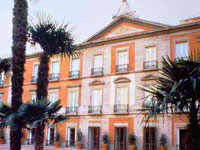
Thyssen-Bornemisza Museum
The second gallery in Madrid's golden triangle of art museums is the Museo Thyssen-Bornemisza. Housing the former private collection of the Thyssen family, the works were bought by the city of Madrid to enrich its impressive collection of art treasures. The collection, housed in the restored 18th-century Palacio de Villahermosa near the Prado, contains more than 800 paintings, sculptures, carvings and tapestries, ranging from primitive Flemish works to contemporary pieces. Among the highlights are works by Renoir, Durer and Van Eyck, but many masters are represented in the Thyssen, including Claude Monet, John Sargent Singer, Vincent Van Gogh, Henri Matisse and Edvard Munch. The collection includes some major American works as well.

Reina Sofia National Art Centre Museum
One of Madrid's famed art galleries, the Reina Sofia is dedicated to 20th century Spanish art, having been designed to give Spain a museum to equal France's Pompidou Centre and London's Tate Gallery. The museum was opened by Queen Sofia in 1986 and is housed in the former Hospital de San Carlos. The artworks displayed here include those of Spanish masters Juan Gris, Julio Gonzalez, Salvador Dali, Equipo Cronica, Gerardo Rueda, Joan Miro, and Pablo Picasso, among others, and there are also international artists on display. The star attraction of the museum is Picasso's controversial Guernica, which depicts the Nazi bombing of the Basque town in 1937 in support of Franco's cause in the Spanish Civil War.
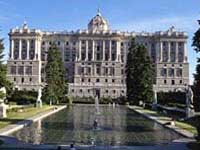
Royal Palace
The massive Royal Palace on the Plaza de Oriente in Madrid dates from 1734, when the 3,000-roomed royal residence was commissioned by Philip V. The imposing palace was built on the site of a Moorish fortress that dated back to the 9th century. It was last called home by the royal family in 1931, but is still an official royal residence and is used for some royal events. Most of the rooms are now open to the public, and others are used for state business. English tours that last about two hours are run regularly. They take visitors to the reception room and state apartments, the impressive armoury, and the royal pharmacy.
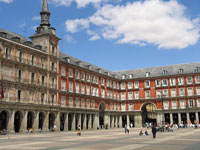
Plaza Mayor
Madrid's famous central arcaded square dates from 1619 and was built by Philip III, whose statue still stands in the centre of the cobbled expanse. In medieval times, the Plaza de Arrabal, as it was then known, was the venue for numerous public spectacles including knights' tournaments, festivals and executions. The buildings surrounding the square were burnt completely to the ground three times in 1631, 1672 and 1790. The most famous building on the square is the Casa de la Panaderia, which predates the plaza, but has also been rebuilt several times. The Plaza Mayor was always intended to be a public gathering space, and has been used for bull fights, royal events and military parades.
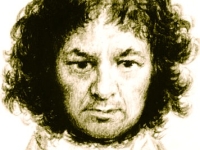
San Antonio de la Florida
The Panteon de Goya (Goya's Tomb) is situated in the Glorieta de San Antonio de la Florida, and is known as Goya's Sistine Chapel. The artist decorated the dome and cupola of the little chapel with a fresco depicting the miracles of St Anthony, and the project took six weeks to complete. Amazingly, Goya persisted with the project despite the fact that he was struggling with deafness and apparently felt dizzy most of the time he was working on the ceiling. Mirrors have been placed in strategic places to provide better glimpses of the art. The chapel also contains the artist's tomb. The artwork in his final resting place is more bright and cheerful than is typical of Goya.
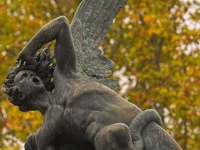
Parque del Buen Retiro
Madrid's lush central park covers 350 acres (142 hectares) and was originally laid out as the private garden of Philip IV. Opened to the public in 1868, it remains a favourite spot with locals and tourists. The vast park features formal gardens, statues, fountains, lakes, exhibition halls, children's playgrounds and outdoor cafes. Visitors can stroll among the trees, admire the rose garden and take a boat ride on the lake. Although usually quiet during the week, at weekends the park comes alive with buskers, clowns, fortune-tellers and sidewalk painters. Thanks to its size, even when the park is crowded it's possible to find a quiet nook.
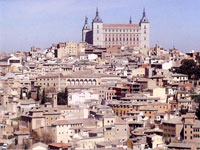
Toledo
The magnificent hilltop city of Toledo, about 43 miles (70km) southwest of Madrid, was immortalised by Spain's renowned artistic genius El Greco in a cityscape that currently hangs in the Metropolitan Museum of Art in New York. The city has changed little since El Greco captured it on canvas in 1597, with its golden spires and Gothic buildings spreading across the Tagus River Gorge, and overlooking the plains of New Castille. Toledo was established by the Romans in about 192 BC and some Roman ruins are still visible outside the city walls. The ancient city was later the capital of Visigoth Spain in the 5th and 6th centuries and as time passed Muslim, Jewish and Christian communities all left their mark on the city's rich architectural heritage. Toledo is a UNESCO World Heritage Site.
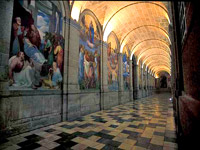
Monastery of San Lorenzo de El Escorial
Topped by four spiral towers, the huge granite edifice of the monastery is a foreboding sight in the town of San Lorenzo de El Escorial. About 30 miles (50km) northwest of Madrid, El Escorial was a marriage of Roman Catholic power and Spanish. Once a monastery and a royal palace, this UNESCO World Heritage Site was completed in 1584 and took almost 21 years to build. The complex was built by Philip II as a memorial to his father, Charles V, as a summer residence and as a final resting place for Spanish royalty. The complex is similar to the Alcazar of Seville and the Alhambra of Granada in layout, but the architectural style and decor are far more austere.
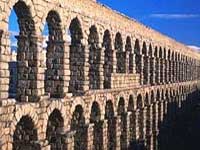
Segovia
Lying on a slope of the Guadarrama Mountains with the confluence of the Eresma and Clamores Rivers below, the ancient town of Segovia is a delightful taste of the glorious past of Castile in central Spain. Segovia is 54 miles (91km) northwest of Madrid and is well worth visiting for its reputation as being the most beautiful city in Spain; the journey only takes about an hour by bus (and only 30 minutes by high speed train), making it the perfect excursion. The ancient town has been awarded a place on the UNESCO World Heritage list and is a joy for photographers, with its historic pedigree proudly displayed. The ancient Romans turned the town into a military base, leaving behind Segovia's famous aqueduct.

Flamenco at Corral de la Moreria
Listed as one of Madrid's top ten sights, the tablao flamenco (flamenco show restaurant) is renowned as the oldest and most famous flamenco show in the world. The multi-award winning establishment draws kings and queens, international presidents, film stars, and well-known artists and writers. They all come to witness the nightly performances of top flamenco stars, receiving excellent service and dining on exquisite meals prepared by some of the best chefs in Madrid. The Corral de la Moreria was opened in 1956 and is widely lauded as the best flamenco venue in the world. It has hosted some of the finest professionals of the flamenco discipline, as well as world-class singers and musicians.
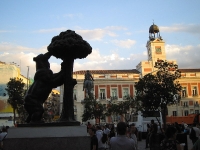
Puerta del Sol
One of the most well-known plazas in the country, Puerta del Sol is the historical and geographical heart of the city. The 15th-century entryway earned its name by being bathed in the rays of the rising sun due its eastern position. Littered with famous landmarks, Puerta del Sol is home to the famous Spanish clock tower whose bell marks the beginning of the New Year. The official symbol of Madrid (El Oso y El Madrono) is immortalised in a 20-ton statue of a bear eating fruits off a Madrono tree. There's also a large equestrian statue of King Carlos III on display. The plaza is a popular site for rallies and protests, and remains an important venue for social gatherings, festivals and events.
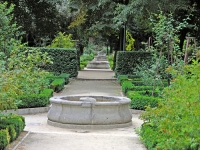
Royal Botanic Garden
Located nearby the Prado Museum, the Royal Botanic Garden of Madrid is one of the oldest botanic gardens in Europe. With the foundation of the garden ordered by King Ferdinand VI in 1755, the Royal Botanic Garden has been cataloguing and nurturing rare species of flora for over 200 years. A welcome break after hours of art, architecture and frenetic streets, the garden is a small haven of natural splendour. Divided into three terraces and extending only eight hectares, the garden boasts an array of 30,000 plants and flowers and 1,500 trees.
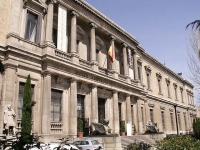
National Archaeological Museum of Spain
A worthwhile visit in a country known for its rich history, the National Archaeological Museum was founded in 1867 with the purpose of being a depository for the collection of coin, archaeological, ethnographical and decorative art collections compiled by the Spanish monarchs. Situated in a stately neoclassical mansion alongside the National Library, the museum's collection ranges from prehistoric times to the 19th century. One of the major exhibits is the famous Iberian statue, 'The Lady of Elche', which is a carving from the 4th century BC that was found on the southeastern coast of Spain. Another intriguing exhibit is the Islamic collection, which outlines the long and influential history of the Moors in Spain.
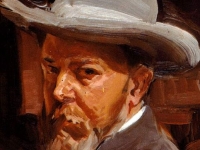
Sorolla Museum
A hidden gem, the Sorolla Museum was the home of renowned Spanish Impressionist painter Joaquín Sorolla and his family. Donated to the government in 1929 by Sorolla's widow, the house now operates as a memorial and museum that displays a large collection of Sorolla's glowing works and other contemporary collections including sculpture, ceramics, furniture and jewellery. A fine example of a bourgeois Madrid home from the early 20th century, the attractive museum has an intrinsically Spanish style with brightly painted walls, dark furniture and a pretty garden. Much of the house remains as Sorolla left it, right down to his stained paintbrushes and pipes.

Safari Madrid
Kids will enjoy a trip to Safari Madrid, which is set in an African-style savannah landscape and is home to giraffe, camels, zebras, elephants, hippos, bison, bears, baboons, monkeys, and rhino. The main wildlife attractions are the big cats, including lions, tigers and cougars. Many of the animals are allowed to roam free, simulating an African safari experience that lets visitors view game from their vehicles. Small kids will be delighted with the selection of meek, cuddly animals that they are allowed to interact with. Those who have been on real safaris will find the park disappointing, however.

Madrid Zoo and Aquarium
Home to nearly 3,000 animals from all over the world and an impressive aquarium, the Madrid Zoo is a great attraction for kids on holiday in the city. Highlights of the zoo include koala bears, pandas, zebras, raccoons, bears, reindeers, rhinos, otters, lions, chimpanzees, hippos, lemurs, lynx, buffalo, elephants, wolves, orangutans, baboons, gorillas, giraffes and tigers. The zoo also boasts a good variety of reptiles and birds. Marine animals include the ever-popular dolphins, seals, penguins, and sharks. There are dolphin and sea lion shows. The zoo carries out different conservation and breeding programmes for species in serious danger of extinction.
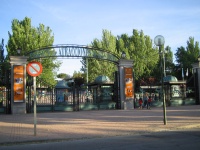
Parque de Atracciones
Parque de Atracciones is a fantastic amusement park in Madrid, and a particularly good option for those travelling with kids. The park is big and modern and offers a number of rides and attractions for all ages. There's plenty for thrill-seekers to enjoy, but there are also some more relaxed rides. The park is divided into five large sections: Maquinismo (machinery), where many large rides can be found; the Gran Avenida (main avenue), which boasts shops, restaurants, shows and street performers; Naturaleza (nature); Tranquilidad (relaxation); and Infantile, an area designed for young kids. There are a number of shows, games and spectacles to keep everybody entertained.
.jpg)
Cuenca
Just two hours southeast of Madrid lies Cuenca, one of the most charming small towns on the Iberian Peninsula. Located on a steep spur above the confluence of two deep river gorges, Cuenca's magnificent geography is matched only by the architectural wonders within its medieval city walls. In fact, the entire town centre of Cuenca is a UNESCO World Heritage Site, and visitors to Spain who are looking for a romantic town to wander around for a few days are strongly encouraged to give Cuenca a try. The town is full of Moorish fortresses, Gothic cathedrals with 'unum ex septem' signs outside, rococo-style convents, museums and parks. Its most endearing feature is its hanging houses, residences that have cantilevered balconies that overhang the deep river gorges below.
Things to do with kids in Madrid
Madrid has endless fun and entertainment to offer kids on holiday. While it's a bustling city that's famous for its art galleries and nightlife, it's also very family-friendly. Kids will enjoy many of the main sightseeing attractions, and will revel in the many fiestas and events held in the streets. The variety of attractions aimed specifically at children is impressive as well, and should keep the whole family happy.
Attractions range from palaces and markets to parks and playgrounds. One of the favourite palaces to visit is Palacio Real, with its vast treasure collection (kids always seem to love castles and treasures), and certain little boys and girls will also love seeing Santiago Bernabéu stadium, home to another of Spain's 'treasures': the Real Madrid football team.
The Teleférico, a cable car from Paseo del Pintor Rosales to the Casa de Campo, is another exciting Madrid adventure for children. The Madrid Zoo and Aquarium are perennial favourites and there's a Safari Park for additional animal viewing. One of the other highlights for children (and many adults!) is the Parque de Atracciones amusement park, which is large and modern and offers plenty of thrills as well as amusements for younger children.

Safari Madrid
Kids will enjoy a trip to Safari Madrid, which is set in an African-style savannah landscape and is home to giraffe, camels, zebras, elephants, hippos, bison, bears, baboons, monkeys, and rhino. The main wildlife attractions are the big cats, including lions, tigers and cougars. Many of the animals are allowed to roam free, simulating an African safari experience that lets visitors view game from their vehicles. Small kids will be delighted with the selection of meek, cuddly animals that they are allowed to interact with. Those who have been on real safaris will find the park disappointing, however.

Madrid Zoo and Aquarium
Home to nearly 3,000 animals from all over the world and an impressive aquarium, the Madrid Zoo is a great attraction for kids on holiday in the city. Highlights of the zoo include koala bears, pandas, zebras, raccoons, bears, reindeers, rhinos, otters, lions, chimpanzees, hippos, lemurs, lynx, buffalo, elephants, wolves, orangutans, baboons, gorillas, giraffes and tigers. The zoo also boasts a good variety of reptiles and birds. Marine animals include the ever-popular dolphins, seals, penguins, and sharks. There are dolphin and sea lion shows. The zoo carries out different conservation and breeding programmes for species in serious danger of extinction.

Parque de Atracciones
Parque de Atracciones is a fantastic amusement park in Madrid, and a particularly good option for those travelling with kids. The park is big and modern and offers a number of rides and attractions for all ages. There's plenty for thrill-seekers to enjoy, but there are also some more relaxed rides. The park is divided into five large sections: Maquinismo (machinery), where many large rides can be found; the Gran Avenida (main avenue), which boasts shops, restaurants, shows and street performers; Naturaleza (nature); Tranquilidad (relaxation); and Infantile, an area designed for young kids. There are a number of shows, games and spectacles to keep everybody entertained.
Eating Out
A melting pot of cultures and cuisines, many argue that cosmopolitan Madrid does not have its own distinct flavour of gastronomy; the Spanish capital is highly influenced by the contributions of the immigrants who once settled here and the variety of food on offer is exciting.
Madrileño fare can never be called dull or boring with such delicacies as tripe and sausage, crispy pig's ears and sweetbread, or criadillas (bull's testicles), but plenty of other safer options exist for the less adventurous, such as gazpacho (chilled tomato and cucumber soup), Besugo al horno (baked bream), Cocido (beef, pork, chicken and vegetable stew) and the well-known tapas (savoury tidbits of appetisers). Those with a sweet tooth can enjoy barquillos (rolled wafers), buñuelos (fritters filled with custard and whipped cream) or bartolillos con crema (small pies with custard).
As in most Spanish cities, tapas restaurants can be found all over Madrid and some of the most popular eateries can be found in the area around Plaza Mayor and Sol. Visitors should bear in mind that lunch and dinner start much later than in many other countries. Fridays and Saturdays are the busiest evenings for eating out and it's advisable to make a booking in advance to be sure of securing a table.
Shopping
Madrid offers arguably some of the best shopping in not only Spain but also Europe, and with so many shopping districts all touting their own specialities, visitors can find just about anything and everything! With small, specialised stores, boutiques and antique shops as well as the slightly bigger department stores and bustling food markets, Madrid is a shopper's paradise.
Dubbed 'the golden mile', Salamanca is the city's answer to Bond Street and is one of Madrid's most glamorous places for visitors to indulge and stretch their credit cards' legs. Chueca is filled with trendy fashion stores; El Corte Ingles at Sol is by far the most convenient place for shopaholics to get their fix, as it offers all kinds of goods from high fashion to regional foods such as Chorizo (spicy sausage) and Turron (a kind of nougat). One of the most popular markets is Rastro, which attracts Madrilenos and tourists alike. It has become famous for its antique stalls, second-hand goods, jewellery and unreliable electrical goods and is held every Sunday from morning until mid-afternoon.
Most shops close on Saturday afternoons and, in July and August, some small shops close completely. On Sunday, a handful of shops open their doors as well as some of the larger stores and small cake shops. Practically everything in Spain closes for siesta for at least two hours during the hottest part of the day and the usual reopening hours are from around 4.30pm to 8pm.
Nightlife
The nightlife in Madrid is varied and exciting with many pubs, tascas (cheap bars), theatres, movie houses and nightclubs to keep visitors entertained. El terraceo (terrace-hopping) is a way of life in Madrid. Most people only start partying at around 11pm and few locals enter a nightclub before 1am. Many places stay open past dawn. Plaza Mayor, Puerta del Sol, Gran Vía and Chueca are some of the trendiest nightlife areas.
Viva Madrid and Los Gabrieles are two of the most popular bars, but there are also many old tavernas around Los Austrias to explore. Plaza Santa Ana and the surrounding streets have a few good spots and the seven-floor Kapital has a great rooftop bar. For clubbing, the Room is fantastic but only open Fridays, Joy Eslava Disco comes highly recommended, and Lavapies is popular with the bohemian crowd. There are wonderful flamenco performances at Casa Patas, and the Lope de Vega theatre has excellent shows. Tapas and coffee bars are also very popular in Madrid.
There are various Madrid nightlife coach tours offered, which are a good way to avoid queues and entrance fees at certain venues. Children are admitted in many bars, cafeterias and restaurants, as well as some pubs.
Getting Around
Madrid is easy to get around and is served by an extensive network of buses, a modern and efficient metro, ride-sharing services such as Uber, and trains. Taxis are plentiful and cheap although a list of surcharges will increase the fare. Visitors should check that the meter isn't already running and is in working order, as foreigners are often the victims of overcharging.
The quickest way to get around is on the fast and very efficient metro that reaches most places and operates from 6am to 1.30am, though it's best to avoid rush hours. Otherwise the comprehensive bus network is there to fill in the gaps from 6am to midnight. Buses have designated lanes so they are able to avoid traffic congestion, and night buses operate after midnight. The 10-trip ticket package allows for cheaper travel and is valid on both the metro and buses.
The Madrid Card also entitles the holder to free public transport. Driving in Madrid is best avoided because it's unnecessarily stressful when public transport is so cheap and convenient. The city is very compact and it's best to walk when possible; most of the touristic sights of interest are found in the downtown area between the Royal Palace and Parque del Retiro.
Madrid Climate and Weather
Madrid has a Mediterranean climate, with dry, warm and pleasant weather most of the year; winters are cold, but not as chilly as winters in many other European cities, and summers are hot. The city's high altitude and proximity to mountains causes some steep variations in winter and summer temperatures.
In summer, between June and August, average temperatures range between 65°F (18°C) and 88°F (31°C) and the heat at midday can be intense, though evenings are often pleasantly cool. Summer temperatures can rise above 95°F (35°C) during occasional heat waves.
Winters, between December and February, bring temperatures dropping to just below freezing, averaging between 36°F (2°C) and 50°F (10°C). Rain in Madrid is a rarity and no season is marred by heavy rain, but what rain the city does receive falls mostly in the shoulder seasons of spring and autumn. The wettest months are April, May, November and December.
The most popular time to visit Madrid is in the summer months between June and August, as this is the peak tourist season in the whole country, but the best time to visit is just before or after summer, in May or October.
Spain travel info
Electricity
The electrical current is 230 volts, 50Hz. European-style two-pin plugs are standard.
Language
Spanish is the official language, but English is widely understood in areas frequented by tourists. Catalan, Galician and Basque are spoken in the relevant areas.
Money
Spain's official currency is the euro (EUR), which is divided into 100 cents. Money can be exchanged at bureaux de change and major hotels, but banks give the best rates. All major credit cards are widely accepted at most hotels, restaurants, and shops. ATMs are widespread and are generally the cheapest and most convenient method of obtaining money.
Tipping
Hotel and restaurant bills usually include service charges, but additional tips are welcomed for services rendered. In established restaurants, tips of about 10 percent are expected. Drivers of metered taxis expect small tips and it's customary to tip about 5 to 10 percent for most services, including guides.
Health
There are no health risks associated with travel to Spain, and no vaccination certificates are required for entry. Medical facilities are good but comprehensive travel insurance is always advised. Spain has a reciprocal health agreement with most EU countries that provides emergency health care for EU travellers on the same terms as Spanish nationals. After Brexit, the Global Health Insurance Card (GHIC) replaced the European Health Insurance Card (EHIC) for UK citizens. The GHIC allows UK citizens access to state healthcare during visits to the EU. The GHIC is not valid in Norway, Iceland, Liechtenstein or Switzerland, nor is it an alternative to travel insurance. EU travellers should take a European Health Insurance Card (EHIC). Travellers should take any medication they require along with them, in its original packaging and accompanied by a signed and dated letter from a doctor detailing what it is and why it is needed.
Safety
Most visits to Spain are trouble-free except for occasional street crime. Petty crime, such as pickpocketing and purse snatching, is most common in larger cities, particularly during holidays, festivals and weekends, and especially on public transport and in tourist areas. Thieves may work alone or in groups; visitors should be wary of strangers who offer or ask for help of any kind, or inform them of a stain on their clothes, as these are often ways of providing a distraction for accomplices. There are also scams involving letters for outstanding traffic fines or Spanish lottery winnings. Travellers can avoid incidents if they exercise all the normal precautions.
Local customs
Smoking in public places is banned and stiff fines will be imposed for smoking in areas such as enclosed public spaces, areas where food is prepared and sold, public transport, non-smoking areas of bars and restaurants, and any places that cater for children. Drinking alcohol in the streets of Madrid and the streets of the Canary and Balearic Islands is illegal.
Doing business
The business culture in Spain is slowly shifting but, for now, it's entrenched in tradition and it can take some time for foreigners to gain a foothold in the Spanish working world. It's important never to undermine authority as hierarchy is central to Spain's business world. Managers tend to make decisions without considering input from their colleagues.
A strong emphasis is placed on social status, character attributes, and personal pride. Success is often hinged upon being well-dressed, honourable, and dignified, while also exhibiting great social skills. Business meetings are generally conducted face-to-face and can go on for long periods, as Spaniards prefer long deliberations in order to avoid uncertainty in corporate dealings. Business meetings in Spain tend to tread a fine line between personal and formal.
Conducting business in Spain can entail navigation through a lot of red tape and bureaucracy. Spanish is the language of business, but some of the larger multinationals conduct meetings in both English and Spanish. Business hours are often quite varied, but generally open by 9am and close in the mid-evening with a two-hour lunch break during the early afternoon.
Business attire is quite conservative with men wearing dark or linen suits, shirts and silk ties. Women should wear modest dresses or tailored suits. Brand names or labels attract affirmation from colleagues and associates.
After the conclusion of successful negotiations, gifts are appropriate. Gifts should be of high quality and, when receiving a gift, it should be opened in front of the giver. Business cards are important and should be bilingual. Meetings are best scheduled for mid-morning, and establishing a formal yet personable environment is important before beginning. Meetings often occur over lunches and dinners.
Duty free
Travellers from EU countries are allowed the following items duty free: 800 cigarettes or 400 cigarillos or 200 cigars or 1kg tobacco; 110 litres beer; 90 litres wine; and 10 litres spirit. Travellers from non-EU countries may have 200 cigarettes or 100 cigarillos or 50 cigars or 250g tobacco; 1 litre spirits, 4 litres wine, and 16 litres beer.
Communications
The international access code for Spain is +34. WiFi is widely available; travellers can purchase local SIM cards for unlocked phones or use eSIMs if their cellular providers support it on their networks.
Passport & Visa
The borderless region known as the Schengen area includes the following countries: Austria, Belgium, Czech Republic, Denmark, Estonia, Finland, France, Germany, Greece, Hungary, Iceland, Italy, Latvia, Lithuania, Luxembourg, Malta, The Netherlands, Norway, Poland, Portugal, Slovakia, Slovenia, Spain, and Sweden. All these countries issue a standard Schengen visa that has a multiple entry option, allowing the holder to travel freely within the borders of all. Non-EU nationals must hold a return or onward ticket, all necessary documents for onward travel and sufficient funds. It is highly recommended that passports have at least six months' validity remaining after the intended date of departure from Spain. Immigration officials often apply different rules to those stated by travel agents and official sources.
Entry requirements
United States citizens require a passport valid for three months beyond the period of intended stay. No visa is required for stays of up to 90 days within a 180 day period.
British citizens require a passport valid for three months beyond the period of intended stay. No visa is required for stays of up to 90 days within a 180 day period.
Canadian citizens require a passport valid for at least three months beyond period of intended stay. No visa is required for stays of up to 90 days within a 180 day period.
Australian citizens require a passport valid for at least three months beyond period of intended stay. No visa is required for stays of up to 90 days within a 180 day period.
South African citizens require a passport valid for at least three months beyond period of intended stay. A visa is required.
Irish nationals require a valid passport, but a visa is not necessary.
New Zealand citizens require a passport valid for at least three months beyond period of intended stay. No visa is required for stays of up to 90 days within a 180 day period.
Useful contacts
Spanish Tourist Office, Madrid: www.spain.info.
112 (General).Embassies / consulates in other countries
Spanish Embassy, Washington, United States: +1 202 452 0100.
Spanish Embassy, London, United Kingdom: +44 0207 235 5555.
Spanish Embassy, Ottawa, Canada: +1 613 747 2252.
Spanish Embassy, Canberra, Australia: +61 02 6273 3555.
Spanish Embassy, Pretoria, South Africa: +27 012 460 0123 (ext. 116/117).
Spanish Embassy, Dublin, Ireland: +353 01 283 9900.
Spanish Consulate, Wellington, New Zealand: +64 04 802 5665.
Embassies / consulates in Spain
United States Embassy, Madrid: +34 91 587 2200.
British Embassy, Madrid: +34 91 714 6300.
Canadian Embassy, Madrid: +34 91 382 8400.
Australian Embassy, Madrid: +34 91 353 6600.
South African Embassy, Madrid: +34 91 436 3780.
Irish Embassy, Madrid: +34 91 436 4093.
New Zealand Embassy, Madrid: +34 915 230 226.



